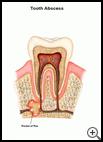
Tooth Abscess
________________________________________________________________________
KEY POINTS
- A tooth abscess is a pus-filled sac around an infected tooth. The abscess can be at the root of a tooth or between the gum and a tooth.
- Root canal therapy is the usual treatment for an abscess at the root of a tooth. A root canal treats the inside of the tooth to remove infection. If you have an abscess between the gum and a tooth, your dentist will drain the infection and carefully clean the area.
- Follow the full course of treatment prescribed by your dentist. Ask your dentist how to take care of yourself at home.
________________________________________________________________________
What is a tooth abscess?
A tooth abscess is a pus-filled sac around an infected tooth. Pus is a thick fluid that usually contains white blood cells, dead tissue, and germs.
The abscess can be at the root of a tooth or between the gum and a tooth.
What is the cause?
Most abscesses are caused by bacteria. Your immune system, which is your body’s defense against infection, sends white blood cells to kill the germs. A pocket forms in the area to keep the germs from spreading to other parts of the body. If the germs keep growing, the tissues around the abscess get swollen and painful.
An abscess at the root is usually caused by severe tooth decay, bone disease, or injury. When decay gets inside the tooth, the infection can spread to the root and to your jawbone.
An abscess between a tooth and gum usually forms when bacteria and food get trapped in an area that is hard to clean.
Sometimes the cause of an abscess is not known.
What are the symptoms?
Symptoms may include:
- Tooth or gum sensitivity to heat and cold (although you may get relief from ice water)
- Pain with chewing
- Redness and swelling of the gums
- Tender glands in the neck
- Swollen face or cheek
- A bad taste in your mouth
- A tooth that feels loose or is discolored
- An open, draining sore on the side of the gum
- A change in how your teeth fit together
How is it diagnosed?
Your dentist will ask about your symptoms and medical history and examine your teeth. You may also have X-rays.
How is it treated?
Abscess at the root of a tooth
Root canal therapy is the usual treatment for an abscess at the root of a tooth. A root canal treats the inside of the tooth to remove infection. A dentist or an endodontist may do the root canal. You may need surgery to remove diseased tissue.
When root canal therapy or surgery is not possible, your dentist may have to pull the tooth. You may need to wear an implant, a bridge, or a removable partial denture to replace the lost tooth.
Abscess between the gum and a tooth
If you have an abscess between the gum and a tooth, your dentist will drain the infection and carefully clean the area. Before doing this procedure, your dentist will give you a shot of medicine to numb the gum and tooth.
Your dentist may also prescribe an antibiotic and recommend a follow-up visit.
You may need gum surgery to decrease a deep pocket and make the gum tissue easier to keep clean and free from infection.
If you have an area that tends to trap food every time you eat, a filling may be placed to close the space.
How can I take care of myself?
Follow the full course of treatment prescribed by your dentist. In addition, you can:
- Rinse your mouth 3 to 4 times a day with warm saltwater.
- Take nonprescription pain medicine, such as acetaminophen, ibuprofen, or naproxen. Read the label and take as directed. Unless recommended by your healthcare provider, you should not take these medicines for more than 10 days.
- Nonsteroidal anti-inflammatory medicines (NSAIDs), such as ibuprofen, naproxen, and aspirin, may cause stomach bleeding and other problems. These risks increase with age.
- Acetaminophen may cause liver damage or other problems. Unless recommended by your provider, don't take more than 3000 milligrams (mg) in 24 hours. To make sure you don’t take too much, check other medicines you take to see if they also contain acetaminophen. Ask your provider if you need to avoid drinking alcohol while taking this medicine.
- Chew on the other side of your mouth.
- Drink plenty of fluids.
Ask your dentist:
- How long it will take to recover
- If there are activities you should avoid and when you can return to your normal activities
- How to take care of yourself at home
- What symptoms or problems you should watch for and what to do if you have them
Make sure you know when you should come back for a checkup. Keep all appointments for dental visits or tests.
How can I help prevent a tooth abscess?
The best way to prevent an abscess is to keep your mouth as free from bacteria as possible by brushing at least twice a day and flossing daily. Have regular dental checkups.

